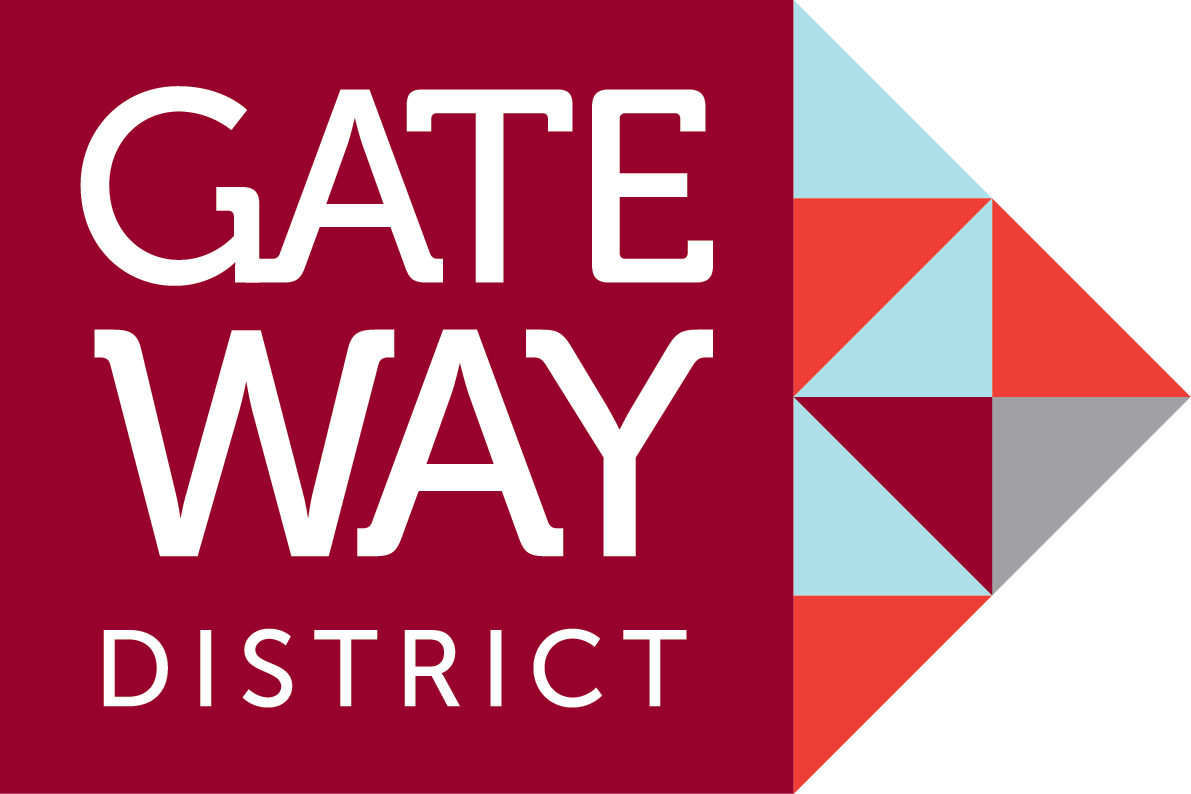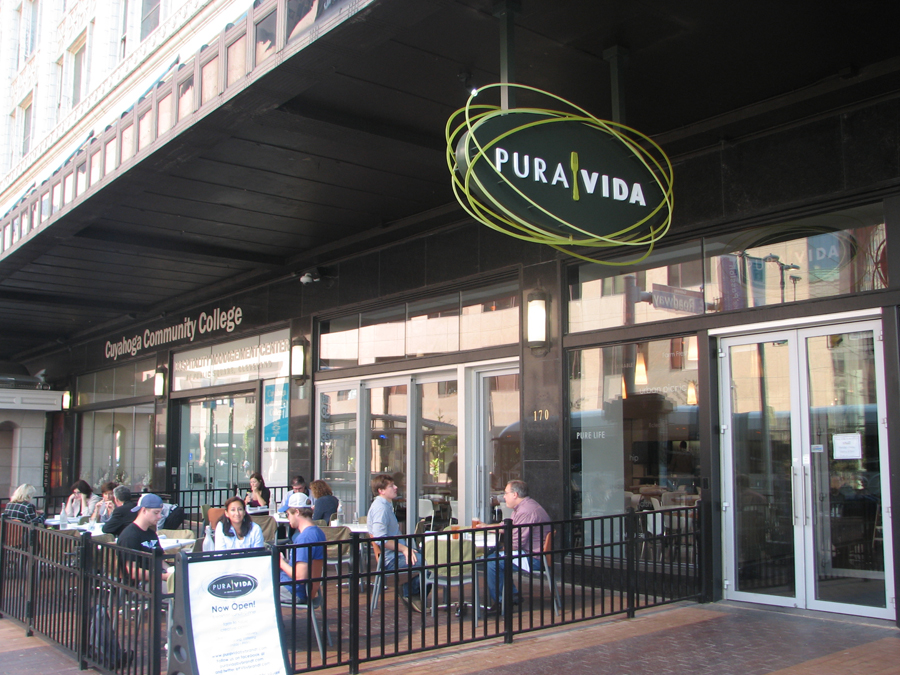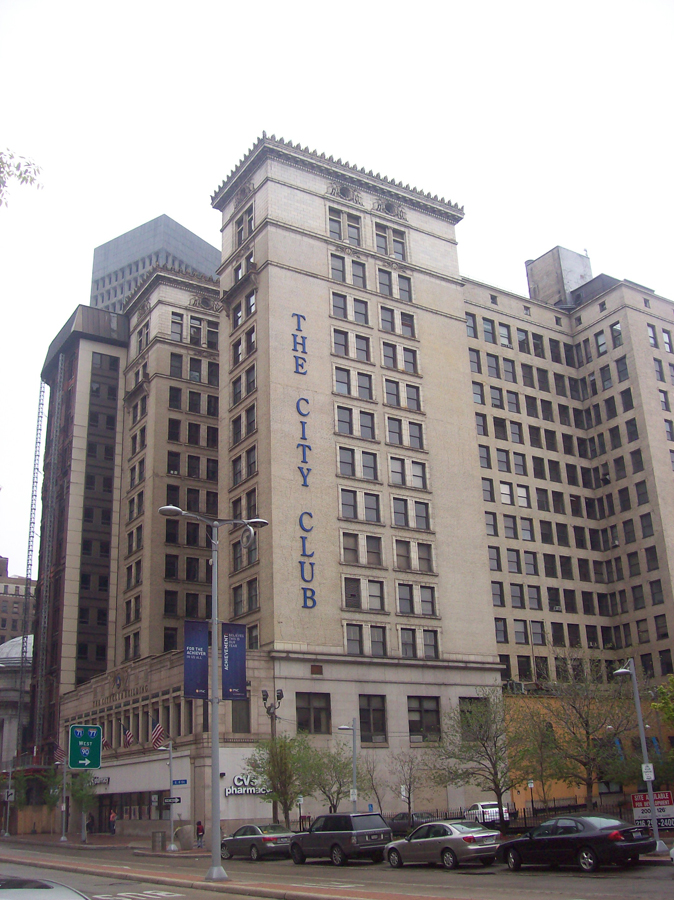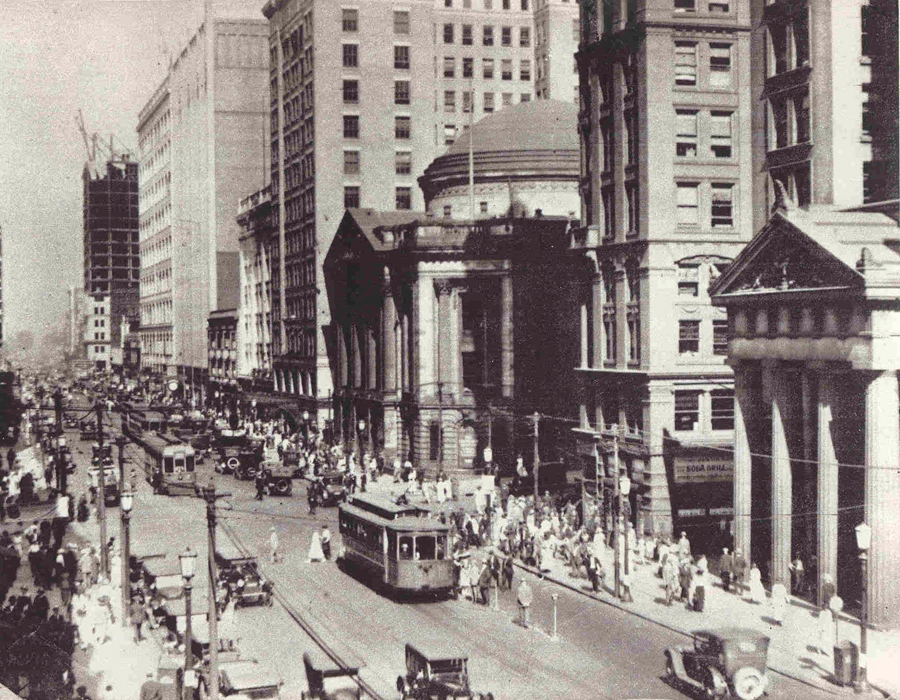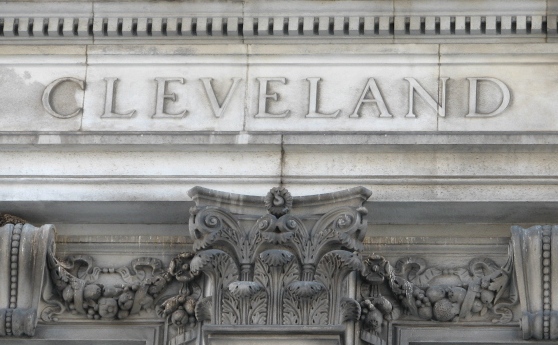While strolling down Euclid Avenue from Public Square to East 9th Street, think back to the days of Dime Stores, grand banking lobbies, beautiful window displays and elegant Downtown Department Stores.
Today, Euclid Avenue is highlighted by public art in the form of benches, flowers, and tree grates, fine dining establishments, such as The Chocolate Bar, high profile businesses, such as Rosetta, and banks, such as Dollar Bank, Huntington Bank and PNC. Euclid Avenue’s grand history continues to evolve before your eyes.
1. Park Building on Public Square
The Park Building on Public Square was built in 1904. It is the western most building in the Lower Euclid Avenue Historic District. Euclid Avenue emerged in the early 20th Century as Cleveland’s main commercial street. The “Millionaire’s Row” homes of the late 1800s gave way to a street that rivaled New York’s Fifth Avenue and Chicago’s Michigan Avenue.
The Park Building was constructed during the Mayoralty of Tom Johnson, one of the historic figures portrayed in the Take a Hike walking tour program. In its heyday, it had two levels of storefronts, including an English basement Rathskellar. Into the 1980s, long-time establishments, such as Hough Bakery and Morrow’s Nut House still captivated the passer-by with rich aromas.
Today the building has been converted to condominiums. The grand opening was held April 16, 2009, and Public Square once again became home to families – something not seen since the 19th century.
2. May Company Building
Continuing down Euclid Avenue, the magnificent May Company Building, previously headquarters of the May Company Department Store, now houses the Tri-C Hospitality Management Center. Built in 1914, the building was originally only as tall as the Park Building. In 1931, two additional stories were added. The May Company Department Store was closed in 1992 as part of a merger with Kaufmann’s Pittsburgh.
3. W.T. Grant Store
The next building of note on Euclid Avenue is the historic W.T. Grant Store, which now offers loft apartments. Part of the conversion included restoring the ornate Victorian Era apartment building to the west, which was formerly covered over by a terra cotta front for Baker Shoes/Coles Shoes. The alley between the WT Grant and Woolworth Buildings used to be known as Hickox Alley, after Abram Hickox, who was a blacksmith who used to live in that area. The 1949 “new” Woolworth Building now houses the House of Blues. This was a $12 million restoration project. Woolworth’s, a five and dime store, had formerly occupied the Windsor Block on the corner of East 4th and Euclid.
4. Kresge Building
At the southeast corner of E 4th and Euclid is the Kresge Building, which was built in 1922 for the S.S. Kresge Variety Store. It is famed for its Art Deco detailing, and it was designed by Walker and Weeks. Note the “K’ still found at the top corner of the building. This building now houses part of The Corner Alley.
5. Taylor’s Department Store Building
Continuing east towards East 9th Street, you will find the 1906 Taylor’s Department Store Building, Cleveland’s first grand terra cotta Department Store, on your right. A 1960s covering was exposed in recent years allowing for the restoration and adaptive re-use into the 668 Euclid Loft Apartments.
The Hippodrome Theatre, one of the nation’s largest and most elaborate theatres, once stood to the east of 668. It was demolished in 1980 to become a parking lot.
6. Guardian Bank Building
On your left, the Holiday Inn Express Hotel & Suites welcomes guests to the 19-century Guardian Bank Building, originally known as the New England Building. The building was designed by Shepley, Rutan and Coolidge of Boston in 1895-96. Major interior and exterior renovations took place in 1915 under the design of the architects Walker and Weeks. An elaborate banking hall on the western side of the building has been used by National City Bank, now PNC Bank, since 1944.
The New England Building is connected on the west to the 1893-4 National City Bank Building, originally known as the Garfield Building, on the corner of E. 6th St. and Euclid, and to the east by the 1980 National City Center, now PNC Center, on the corner of E. 9th St. and Euclid.
Visitors are encouraged to explore the museum-quality exhibits of The PNC Legacy Project in the PNC Center atrium. This free exhibit features select artifacts and recordings of oral history presented by long-time employees, customers and community leaders. Artifacts include currency printed by National City in the early twentieth century, historical photographs of employees and innovations, and a telegram from President Franklin Delano Roosevelt announcing the bank holiday beginning March 6, 1933.
7. Citizens Building
Across the street to the south is the Citizens Building, designed by Hubbell and Benes in 1902. It originally featured beautiful pillars reminiscent of a Roman Temple entrance. The building is home to the City Club of Cleveland (www.cityclub.org), which is celebrating its centennial celebration in 2012.
The City Club’s mission is to inform, educate and inspire citizens by presenting significant ideas and providing opportunities for dialogue in a collegial setting. It is the oldest independent continuous free speech forum in the country, and is renowned for its tradition of debate and discussion.
Next to the City Club Building, on the southwest corner of Euclid and East 9th stands the Schofield Building. Built in 1901, by Levi Schofield, architect of the Soldier & Sailors Monument on Public Square, the exterior of the building had been modernized so that none of the original façade could be seen until recently. The Schofield Building was awarded state historic tax credits and is in the process of being restored to be used for a 161-room hotel and apartment building.
8. Huntington Building
The Huntington Building, once the Union Trust Bank, is the 20-story structure with over 700,000 square feet of office space at the northeast corner of East 9th and Euclid. It was the largest office building in the city and the second largest in the country when it was built. Its barrel-vaulted banking lobby was the largest in the world. The mammoth building opened in 1924, and was soon occupied by a work force of 6,000. The Union Trust Building was designed by Graham, Anderson, Probst and white, a firm already famous in its Chicago hometown. The firm would, in a few years, become even more famous for its design of the Union Terminal complex at Public Square (the Terminal Tower; Cleveland Union Terminal; the Guildhall; Builder’s Exchange and Midland Buildings; and the Higbee Company Building).
The penthouse floor was originally built as a waiting room for intended dirigible service, which would have directly connected Cleveland with New York and Chicago. The architects did not take into effect the strong wind gusts off Lake Erie which would have made landings extremely risky, so in 1924 the area became the main dining room of the Mid-Day Club, a private club for businessmen. When it opened, it featured the largest private dining space in the city and could accommodate 400 people. The space, with fantastic panoramic views of Downtown Cleveland, is now home to Sammy’s Metropolitan Ball Room, which is available for private events.
9. John Harkness Brown Buildings
Heading east down Euclid Avenue, the John Harkness Brown buildings are on your left. These beautiful buildings, once encased in aluminum panels, have received state historic tax credits. Plans for their restoration will be announced shortly. Below you can see the remnants of the B.R. Baker Co. which was Upper Euclid Avenues largest specialty store for men. Next door, at 1007 Euclid, was the home of Clark’s Colonial Restaurant.
10. Statler Hotel
Originally built in 1912, the Statler Hotel, now Statler Arms Apartments, was designed by the firm of George B. Post and Sons, architect of the Cleveland Trust Rotunda and the New York Stock Exchange. The Statler was one of America’s first chain hotels, first created in Buffalo. The Statler was built with over 1,000 hotel rooms, and each room had its own bathroom, a first. The ground floor was created with a grand lobby surrounded by storefronts connected to the exterior and a large ballroom that could be rented for private events. Both firsts, this was done to help the hotelier recoup some of their operating costs. One of those storefronts was the home of H.W. Beattie & Sons jewelers.
Today, the Statler Arms offers spacious comfort and style with studio, one-, two- and three- bedroom apartments featuring new gourmet kitchens and exceptional amenity spaces.
The parking garage to the west of the Statler Arms used to be the entrance to the Loews Stillman Theatre, which opened in 1916. The Stillman was the first theatre in the City to show an all-sound movie, and this was also the location that screened the original showing of Gone with the Wind. The first of Playhouse Square’s theaters to open, it was also its first to close in 1963. Today, all that remains of the Stillman is the tracing of the lobby’s ornamental plaster adorning the top of the entry ramp.
11. Cleveland Athletic Club
Across the street is the Cleveland Athletic Club building, which was completed in 1911. Interestingly, the CAC was looking for a new home and loved the location. At the time, a 5-story building was under construction, but they were able to strike a deal and alter the design to the 15 stories you see today, with the CAC occupying the top 10 floors. The CAC, which was the city’s finest fitness club, featured a bowling alley, swimming pool, gymnasium, track, boxing ring, as well as several dining facilities. The CAC closed at the end of 2007.
12. Security Federal, Truman & Swetland buildings
On your way back to East 9th Street, you will pass the Security Federal, Truman and Swetland buildings on your left. The Truman Building was aptly named for the son of the Swetland family that developed it. The Swetlands also built the Park Building on Public Square. The Truman building was home to many tenants over the years including the Oppenheim & Collins Company, a manufacturer of women’s clothes. The building is currently being redeveloped in concert with the Schofield Building on the corner of 9th and Euclid and the Security Federal Building. Plans for the Truman Building include residences and retail, and plans for the Security Federal Building include primarily office spaces.
13. Cleveland Trust Rotunda
The Cleveland Trust Rotunda at the southeast corner of Euclid and East 9th Street was home to the Cleveland Trust Company. Founded in 1894, the fast-growing bank soon found itself in need of more working space. The bank commissioned the firm of George B. Post and Sons to build its new headquarters building. Completed in 1908, the bank headquarters included a magnificent Greek-style rotunda lobby with a glass ceiling designed by the firm of Louis Comfort Tiffany. In an era when a company’s stability and prestige were judged by the beauty and sophistication of its offices, the setting conveyed a sense of elegance and also served to assure depositors of the bank’s financial strength. The basement level of the building held a labyrinth of vaults. These seemingly impregnable features further testified to the bank’s stability in an era before federally guaranteed deposit insurance.
If you head south on East 9th Street, you will pass the Cleveland Trust Tower, or Ameritrust Bank Tower. Built in 1971, by modern architect Marcel Breuer and Hamilton Smith, it was originally intended to one of two towers meant to balance the Cleveland Trust Rotunda. Only one tower was ever built, and it was threatened with demolition in 2007.
